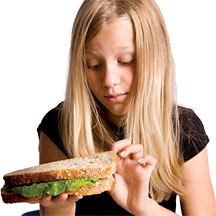Many parents have a daily challenge that goes something like this: “My kids are picky eaters.” Often, this challenge boils down to their children’s tendency to avoid vegetables, but it can include avoidance of numerous other foods – usually the healthy variety. What’s the solution? While there really isn’t a single easy answer, much of this challenge actually stems from your own relationship with food, meaning that many of your childhood habits have persisted into adulthood and are now being passed on to the next generation.
Why It’s Happening

Your child enters this world not knowing what they hate or love about food; for the most part, kids learn by example. If you hate vegetables and never eat them, chances are your children won’t be very willing to try vegetables – and you may be not be particularly interested in serving them. After all, you’ll want to serve the foods you generally eat. If you’re a well-balanced, healthy eater, you’re on the right track, but it doesn’t necessarily mean you won’t have some picky-eater challenges to deal with. However, if you’re a picky eater stuck on a fairly limited number of not-so-good-for-you foods, you’re creating the consummate unhealthy picky eater by your actions, perhaps without even realizing it.
What You Can Do: 9 Strategies
1. Start With You. Where do you begin? It starts right now, whether you’re already a parent or expecting your first child. Start by reviewing your personal relationship with food. Consider how you and your significant other will blend or create new food relationships, and expand your knowledge or cooking base by researching books and Web sites that take a wellness approach to raising healthier children. This is all part of developing a clear strategy for raising your family. It includes the family’s moral compass, discipline and education, of course – and a snapshot of your family in terms of “what in our background could create food issues for our kids,” and the nutritional lifestyle that will grow and fuel your children’s development.
2. You’re the Motivator. If you’ve already created a picky eater, don’t be nit-picky with them (remember, it was you who unintentionally contributed to their picky eating habits). Start by reviewing a week in the life of your family and what everyone eats and drinks, and then divide your dietary lifestyle into two categories: Wellness/Healthy or Processed/Packaged/Unhealthy. Then add a third column, New Strategy, where you can add food items that will help the family get where it needs to go in terms of better eating habits. Evolve your family into the healthier lifestyle, and remember, the motivation has to come from you first.
3. Introduce Variety Early. Regarding infants, it’s ideal to go from breast-feeding to organic baby food, and then consider making your own. Develop a strategy to introduce a wide variety of vegetables, remembering that the greener they are, the more vitamins and minerals they contain, and that vegetables with bright color bring antioxidants to your children’s diet. To prevent your child from developing a sugar addiction, avoid fruit juices, candy, ice cream and baked goods. The only sugar they should experience growing up should come from natural fruit. It’s just too easy to get addicted to processed, overly sweetened foods; they’ll have plenty of time for the occasional treat when they’re older and have already developed a well-rounded, healthy diet.
4. Say No to Processed Foods. Avoid the trap many parents have fallen into, that of buying snacks marketed specifically by the manufacturers to start unhealthy habits. Children’s cereals, colored crackers, cookies and the like are not healthy choices when you see the processing, dyes, and artificial flavors added to make these items “fun” to eat. Also keep in mind that two of the leading food allergies for children are wheat and corn (the latter more often in the form of a sweetener or additive in food products).

5. Think Healthy Snacks. Prepackaged toddler foods seem to be the “in” foods these days, marketed as great for kids and easy for parents. Instead of buying into the marketing hype, pre-plan healthier options for your family. Finely chopped vegetables like red or yellow peppers, shelled snap peas, steamed broccoli heads or zucchini are better than prepackaged items; so are natural fruits – but not fruit rolls and juices, which are high-glycemic. Many whole- or natural food stores also have gluten-free crackers, cookies and breads (wheat often is a food-inducing allergy).
6. Easy Meal Options. Who says you can’t introduce vegetables with breakfast? Chop up, steam or lightly saute veggies and combine with a good source of protein (eggs or beans) and you’re on your way to a complete, tasty meal. Wrap all this up in a whole wheat or sprouted tortilla and you have a healthy breakfast burrito. (The bean family is actually an overlooked source of protein for children.)
For lunches and dinners, it’s important to find a balance with proteins, vegetables, salads and whole grains. If you’re thinking, “How do I start?” realize there are resources and recipes that have been developed by parents who are in the same position as you are. A quick Internet search will get you started in the right direction.
7. Make It Fun. Depending on the age of your children, create fun recipes around themes to get them involved and excited about the meal. For example, “Pirate Night” may include fresh fish, seaweed mash (spinach and mashed potatoes) and stolen treasures (a medley of fresh berries) for dessert. Or try “Princess Night,” which will vary in terms of menu depending on which princess you are mimicking. Example: Jasmine Night can feature Genie chicken cubes and lantern (use couscous, a wonderful grain) or magic carpet dip (hummus) for veggies, and golden jeweled dessert (pineapple cubes with a sprinkle of coconut shreds).
8. It’s OK to Negotiate. If you’ve created a truly picky eater who demands only certain foods, like macaroni and cheese, pizza, hot dogs, fast foods and sweets, you need to learn the art of negotiation. Remember, your kids are in a pattern of getting what they want. Start with a strategy of slowly eliminating certain foods from your home and dining table. Let your children know what you are doing and that it will not happen all at once, and don’t be afraid to ask for their input, but also don’t back down. (Note: Negotiation should not mean “You can have dessert if you finish your food.” Dessert should not be construed as a reward. Negotiation is really about getting your children to try new things without “forcing” them to do it.)
9. Take Charge. Grocery shopping without your children can help to eliminate aisle battles. And consider signing up your older children for cooking classes. If you’re having trouble getting them to adopt more nutritious foods as you eliminate some of their unhealthy favorites, you can ensure good nutrition by purchasing “green” flakes (which can be found in natural stores) and mixing it into foods to camouflage its appearance.
In the beginning, when you are a slowly replacing your family’s old habits with new ones, it won’t be easy. Most children actually win this battle because many parents have troubling committing to their new lifestyle. However, the encouraging side is that most picky-eater habits can be changed within 90 days if you stick with it. Remember, it all starts with you. Teach your children healthy nutrition habits, lead by example and enjoy the results!

More Do’s and Don’ts for Dealing With a Picky Eater
The Mayo Clinic (www.mayoclinic.com) offers some sound suggestions for what to do (and not to do) when trying to broaden the diet of your picky eater. These tips are good for children of all ages, but especially younger children just learning about the wonders of food:
DO: Respect your child’s hunger — or lack thereof. Young children tend to eat only when they’re hungry. Don’t force food on them when they’re not ready for it.
DON’T: Be impatient when introducing new foods. Young children often touch or smell new foods, and may even put tiny bits in their mouths and then take them back out again. They may need repeated exposure to a new food before they take their first real bite.
DO: Make it fun. Serve veggies with a favorite dip or sauce. Cut foods into various shapes with cookie cutters.
DON’T: Expect too much. After age 2, slower growth often reduces a child’s appetite. A few bites may be all it takes to feel full.

DO: Stay calm. If your child senses you’re unhappy with their eating habits, it may turn into a battle of wills. Threats and punishments only reinforce the power struggle.
DON’T: Mandate the “clean plate club.” Don’t force your child to finish all the food on their plate. Again, this may facilitate a power struggle. Allow your child to stop eating when they’re full.
DO: Keep an eye on the clock. No juice and snacks for at least one hour before meals. If your child comes to the table hungry, they may be more inclined to eat.
DON’T: Start too big. Offer several different foods in small portions. Let your child choose what they eat.
DO: Limit liquid calories. Low-fat or fat-free dairy products and 100 percent fruit juice can be important parts of a healthy diet, but too much may make your child too full for meals or snacks.
DON’T: Forget about the routine. Serve meals and snacks at about the same times every day. If the kitchen is “closed” at other times, your child may be more likely to eat what’s served when it’s served.
DO: Leave taste out of it. Instead, talk about a food’s color, shape, aroma and texture — not whether it tastes good.
DON’T: Offer dessert as a reward. Withholding dessert sends the message that dessert is the best food, which may only increase your child’s desire for sweets.
DO: Recruit your child’s help. At the grocery store, ask your child to help you select fruits, vegetables and other healthy foods.
DON’T: Expect all their food preferences to change. As kids mature, they tend to become less picky about food. Still, everyone has food preferences. Don’t expect your child to like everything.
DO: Set a good example. If you eat a variety of healthy foods, your child will be more likely to follow your example.
DON’T: Follow convention. If your child isn’t a fan of various ingredients thrown together, “unmix” the food. Place sandwich fixings outside the bread, or serve the ingredients of a salad, casserole or stir-fry separately. As long as they eat it, that’s what matters.
DO: Minimize distractions. Turn off the television during meals, and don’t allow books or toys at the table.
DON’T: Buy anything you don’t want your child to eat, and when you do buy the occasional sweet treat or less-than-healthy snack, don’t put it within easy reach; that’s just asking for trouble.
DO: Be sneaky. Puree vegetables and add them to spaghetti sauce, top cereal with fruit slices, or mix grated vegetables into casseroles and soups.
DON’T: Be afraid to ask for help. Consult your child’s doctor if you’re concerned that picky eating is compromising your child’s growth and development, or if certain foods seem to make them ill.
By Claudia Anrig, DC